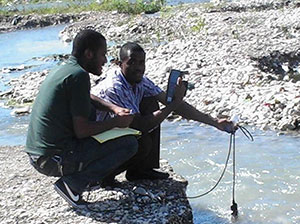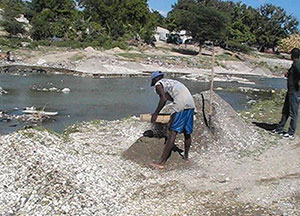The Riviera Grise drains water from the Cul-de-Sac watershed, Haiti, which covers most of the rural areas along the flood plains and areas that extend into steep hillsides. It also covers the urban areas of Port-Au-Prince, the capital city of Haiti. The river drains approximately 290 km2 of watershed area and attains a maximum flow of 475 m3/s during its peak flow and a minimum flow of 0.3 m3/s during drought conditions (US COE, 1999). The headwaters start in the Massif De la Selle mountains and during peak flows, the river discharges into the Gulf of Gonave in the Caribbean sea, which serves as the natural harbor for the port city, Port-Au-Prince.
The hillsides were once covered with vegetation and perennial crops such as coffee. Subsistence farming was practiced on the plains to grow crops such as sugar cane, bananas, and mangoes. Deforestation in the hills over a period of time between 2000 and 2010, along with intensive agriculture, causes extreme erosion during heavy rainfall.
Sediments resulting from erosion are carried across plains and discharged into the river. This has led to severe stream bank erosion and sedimentation of the river (Hylkema, 2011). The entire Port-Au-Prince area was catastrophically affected by a huge earthquake on January 12, 2010, resulting in estimated deaths of more than 230,000 in the capital city. This study evaluated the subsequent deterioration of the river after the earthquake and potential impacts on stream quality.
Project
The study was conducted as part of a larger project aimed at providing assistance to the State University of Haiti Faculty of Agronomy, Medicine and Veterinary Sciences (FAMV) in rebuilding its capacity in water quality analysis. A team of scientists and engineers from the International Water Resources Management at Central State University (CSU), Ohio visited the university as volunteers through assistance from Florida Agricultural and Mechanical University’s Farmer to Farmer Program funded by the United States Agency for International Development.
 Very little information exists on the assessment of water quality in Riviera Grise. During the project, the river was monitored using a YSI Professional Plus (now the ProQuatro) multiparameter handheld. Basic water quality parameters such as pH, total dissolved solids (TDS), dissolved oxygen, specific conductivity, and temperature were measured. Turbidity of the samples was also measured.
Very little information exists on the assessment of water quality in Riviera Grise. During the project, the river was monitored using a YSI Professional Plus (now the ProQuatro) multiparameter handheld. Basic water quality parameters such as pH, total dissolved solids (TDS), dissolved oxygen, specific conductivity, and temperature were measured. Turbidity of the samples was also measured.
The section of the river surveyed is approximately 2 km from FAMV and drains water from agricultural lands close to FAMV. Visual observations indicate the river habitat is severely impacted by artificial channelization. The river carries a lot of sediment which is being manually removed from the river bed to the banks to sieve gravel from silt. Local residents collecting the gravel sell it for construction purposes.
The river is losing significant substrate at the same time providing livelihood to the poor people who are surviving on the river. There is no riparian corridor along the 0.5 mile section the team surveyed. However, some vegetation was noticed along certain sections of the river.
Water samples were tested at one of the riffle and pool areas. The pool section is close to the banks and is experiencing severe algal growth to the extent that DO levels were only 55.8% of saturation value at the prevailing temperatures. No fish were observed along the river. Water sampled on the riffle appears to be in good condition. However, the river is severely channelized, broken by silt and gravel at various sections. Poorer sections of the city depend on the river water for washing, bathing, and in some cases for drinking.
Data
From the table, it is clear that surface water has high amounts of total dissolved solids (TDS) which is indicative of nutrient runoff and inorganic pollution. World Health Organization (WHO) guidelines for TDS suggest the water quality in the river is moderate (300-600 mg/L), however, these levels may be considered unsafe for consumption if the water contains substantial amounts of nitrites/nitrates or phosphates.
Water samples having turbidity greater than 5 NTU are unsuitable for human consumption. High turbidity suggests excessive erosion from the hills followed by sedimentation in the plains. Dissolved oxygen levels on the riffle attained 100% saturation whereas levels in the pool sections close to the river banks were very low due to excessive algae and nutrient enrichment. Higher turbidity values in the pool suggest water pollution from sedimentation and algal growth. The YSI ProQuatro provides researchers with an initial look in analyzing water quality which can be followed with a more precise analysis of the stream. Further analysis is required to determine nitrates and phosphates. This would enable the team to compute the water quality index (WQI), an indicator of stream quality impairment. WQI coupled with the Qualitative Habitat Evaluation Index (QHEI) provides accurate assessments of the current ecological condition of Riviera Grise.
A collaborative effort may be sought among the scientists at FAMV, CSU, and FAMU to establish riparian corridors to restore the natural conditions of the stream. Such a restoration of natural habitat may sustain the aquatic ecosystem in the river. It will also improve stream quality and fish production. People could then find alternate means for a livelihood without disturbing the natural environments of the river and its surroundings.
Steps should be made to encourage poorer people living in heavily populated city centers to move to agricultural plains and hills. This will prevent the risk of house collapses from landslides. Moreover, translocated people may be provided an opportunity to cultivate land on the plains and hills using proven soil conservation practices contributing to reforestation on the hill slides and improved crop productivity on the plains. This will also lead to improvements in stream quality.

References Hylkema, Haiti Soil Fertility Analysis and Crop Interpretations for Principal Cropsin the FiveWINNER Watershed Zones of Intervention, Thesis report, Soil and Water Science, University of Florida, 2011. US Army Corp of Engineers District, Mobile Alabama and US Army Corps of Engineers Topographic Engineering Center, Alexandria, Virginia, Water resources assessment of Haiti, 1999.


Additional Blog Posts of Interest:
Water Quality Monitoring Protects Water Supply in Taiwan Reservoir
Monitoring the Effects of a Forest Invader with a Water Quality Meter
Watershed Partnership Addresses Concerns in a Rural Watershed
Project to Save Rare Freshwater Species - What is a Wadi?